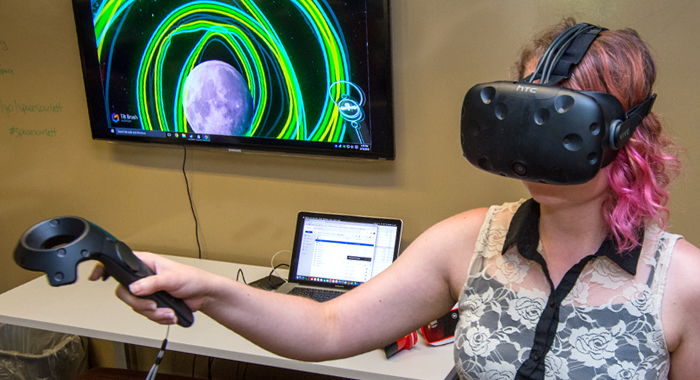St. Norbert Plays in the Digital Sandbox: Part 2
In December, Rachel Mueller ’14 looked at the types of build-your-own tech opportunities students experienced in the physics classroom of Michael Olson with the Arduino microprocessor. She wraps up our two-part series on playing in the digital sandbox by exploring how both virtual reality and augmented reality are becoming viable teaching tools in the typical St. Norbert classroom.
As future employers of SNC students start to incorporate cutting-edge technologies like virtual reality (VR) and augmented reality (AR), and expect even more tech-related skills from new graduates, the academic technology team in Information Technology Services (ITS) has a clear mission in mind.
Work with faculty to get these tools into the classroom and into the hands of students.
From buzzword to tangible teaching tool
While virtual reality allows you to immerse yourself in a completely different space and simulates a seemingly real environment, augmented reality maintains a connection to your current physical world, but overlays it with new information. The popular mobile app Pokémon Go is one example of AR. Users “catch” digital Pokémon at well-known spots and historical landmarks.
VR use has already gained momentum. Now that ITS offers the HTC Vive and Google Expedition kits, staff are working with faculty members on ways to integrate these tools into academic courses.
“Since most students carry smartphones wherever they go, we currently offer to work with professors on different ways to use the Google Expeditions mobile app in their lessons,” says Ben Hommerding, one of SNC’s instructional technologists. “With these smartphone-friendly kits, professors can engage all their students at the same place at the same time. And maybe the professor has even been [to the site in question], which gives even more context.”
Google offers these kits as a way for educators to “bring lessons to life.” By simply using a tablet, virtual reality viewers, smartphones and a wireless router, professors can connect all their students to the same virtual world. Google has multiple locations to choose from, but popular expeditions include Machu Picchu, the moon and a variety of national parks.
“We’ve had some great conversations with Gratzia Villarroel and her team in the Center for Global Engagement about this,” says Krissy Lukens, director of academic technology. “Several other professors have checked them out, too, including Mark Glantz (Communication & Media Studies) and Bob Kramer (History). We’re also particularly interested in the ability to create your own expeditions, so keep your eyes out for that!”
While users can’t build an expedition on their own at the moment, Google encourages educators to collaborate on the curation and creation of VR content. They also work with a variety of partners to provide a diverse selection of virtual trips.
Hommerding adds that, as the cost for new technology goes down and availability goes up, there will be no limit to what can be offered on campus: virtual surgeries for medical students at MCW-Green Bay; complete immersion into a language for those studying foreign cultures; or creation of 3-D digital designs by art majors, just to name a few.
He also explains that, the more SNC students interact with STEM-based content and other technologies like VR and AR, the more prepared they will be for future needs in society. By exploring how these technologies work, students will have the ability to see how and why these technologies will affect social norms, change cultures and bring up ethical implications for personal privacy or other issues.
“St. Norbert is committed to always being at the forefront of new technology and exploring ways it will affect our current and prospective students,” Hommerding says. “When students come here, they will have various opportunities to interact with it and talk about it in their classes.”
Feb. 7, 2017












